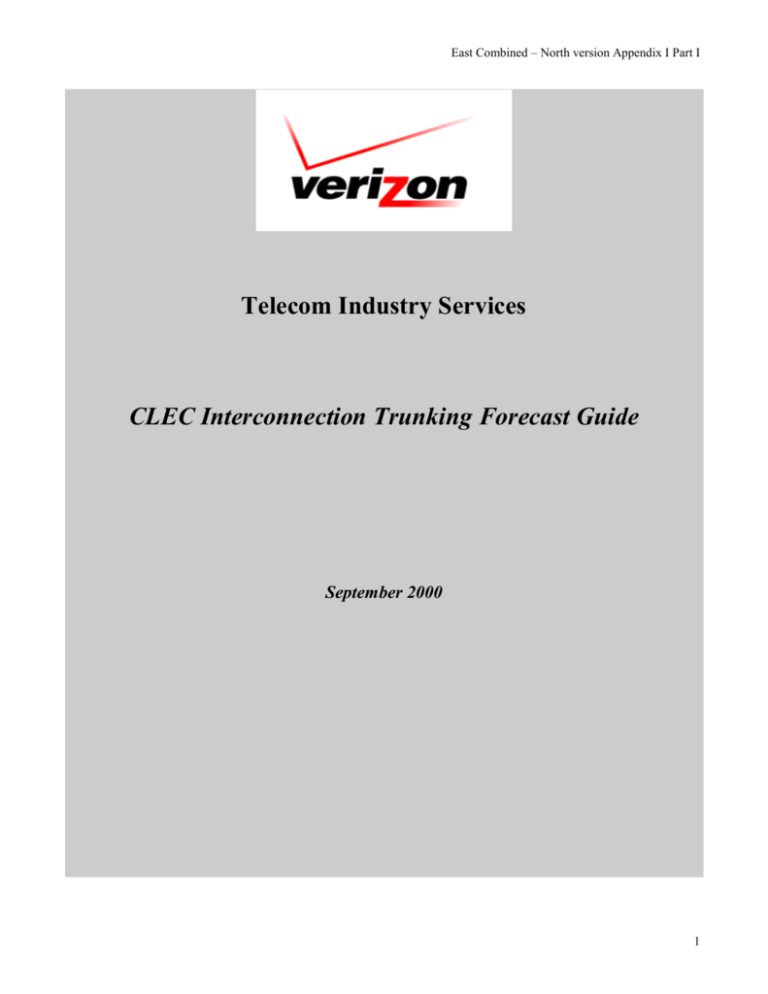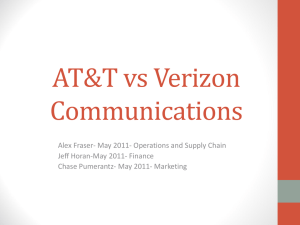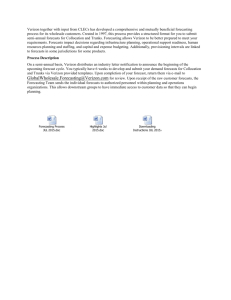1. What Forecasting Requirements Exist?
advertisement

East Combined – North version Appendix I Part I Telecom Industry Services CLEC Interconnection Trunking Forecast Guide September 2000 1 East Combined – North version Appendix I Part I Introduction Introduction The purpose of this CLEC Interconnection Trunking Forecast Guide and attached documents is to provide guidelines for the formats and language to be used in exchanges of forecast information between CLECs and Verizon. These guidelines in no way supersede any established or future Interconnection Agreements between Verizon and individual CLECs. The Verizon CLEC Interconnection Trunking Forecast Process is an interactive planning process between the CLECs and Verizon. This recommended process represents a work in progress and may be modified as appropriate. Initial Implementation The Trunk Forecasting Process was implemented to meet the requirements of Verizon’s forecasting and capital budget process. Evaluation The Trunk Forecasting Process will be monitored by Verizon with input from all CLECs to evaluate the success of the forecast process. CLEC Interconnection Trunking Forecast Process Why Do We Need Forecasts? 1. To ensure that trunk groups do not exceed their design blocking thresholds. 2. To ensure adequate infrastructure planning to meet customer service requirements within standard intervals. 3. CLECs and Verizon analyze forecast information in order to: Design optimum network infrastructure. Prioritize and allocate limited capital funds for next year’s switching, transport and OSS projects. Allocate expense budgets and human resources. Impact of Unforecasted Demand Unforecasted Demand Forces: Blockage that exceeds design blocking thresholds. Redesign of infrastructure network in various areas. Sub-optimization of planned aggregate infrastructure. Reallocation of funds for infrastructure. Reprioritizing, rescheduling, or cancellation of planned projects. Reallocation of human resources. 2 East Combined – North version Appendix I Part I When Will This Trunk Forecast be Provided? On a semiannual basis, CLECs will be requested to provide Verizon with at least a two year detailed forecast of its traffic and volume requirements for all CLEC Interconnection Trunking. This should include requirements for both new growth and change in volumes. This forecast must be provided on February 1st and August 1st each year. To facilitate the forecast, Verizon’s TIS Account Team will send out a letter with a 3.5Mb diskette (with an attached VZ Excel forecast spreadsheet) to each CLEC How will feedback be provided on the process? Verizon will review the forecast and provide feedback to individual CLECs as appropriate. Degree of Confidence The CLEC should strive to provide Verizon with a high degree of accuracy. The remarks section of the forecast template should be used to identify high priority requirements and indicate special considerations. Verizon may use the remarks as a guide for discussions at joint meetings. Distribution of the Official Forecast Forecasts will only be made available to those parties within Verizon with a need to know and will be in compliance with the appropriate Interconnection Agreements. For example, Verizon- Telecom Industry Services, Verizon - Network Forecasting and Network Provisioning groups. A CLEC or Verizon can also request a meeting to discuss the forecast process. Individual CLEC forecasts will not be shared with other CLECs or Verizon Retail. How should each party provide feedback to the other of a spike in demand/project that is Unforecasted for the current year? Each party will notify the other when they project a significant short term spike in demand which has the potential to impact infrastructure and/or workforce balance. This notification will be done via letter to the other party (ex. CLEC obtains a new ISP) via the respective account managers. A copy may be sent to the appropriate provisioning group in Verizon. Joint Network Planning Reviews May be called by either party as required. These meetings will include engineering representatives from each party. May include discussions on changes in POI, additional transport requirements, additional trunking requirements, significant advances or delays in requirements from one year to another. For example, significant changes can include : A new CLEC POI Advancing or delaying significant trunk requirements from one year to another Unforecasted trunking requirements New Switch 3 East Combined – North version Appendix I Part I CLEC Interconnection Trunking Forecast Guide Forecast Template Field Definitions Header Section 1. CLEC Name: DEFINITION: This field identifies the Telecommunications Carrier issuing the trunk forecast. EXAMPLE: ABC Telecom 2. Forecast Issue Date: DEFINITION: This field identifies the date the trunk forecast is issued by the Telecommunications Carrier. EXAMPLE: 2/1/98 3. Issued By: DEFINITION: This field identifies the name and the title of the person issuing the Forecast for the CLEC. USAGE: This information will be used by Verizon to contact the CLEC if additional information concerning the forecast is required. EXAMPLE: Jane Doe, Network Manager 4. Reach Number: DEFINITION: This field identifies the Telephone Reach Number of the CLEC employee who originated this trunk forecast. The field should contain a three-digit area code, three-digit exchange, and a four-digit line number. USAGE: This information will be used by Verizon to contact the CLEC if additional information concerning the forecast is required. EXAMPLE: 1-800-555-1212 5. LATA: DEFINITION: This field indicates the LATA which the trunk group(s) forecast will serve. A separate forecast template should be prepared for each LATA for which the CLEC is providing trunk forecasts. USAGE: This information will be used to distribute the forecasts to appropriate personnel within Verizon. EXAMPLE: 132 4 East Combined – North version Appendix I Part I Trunk Group Specific Section 6. ACTL (Access Customer Terminal Location / POI (Point of Interface): DEFINITION: This field identifies the CLLI Code of the Terminal Location / POI of the CLEC providing the IntraLata Service. If the CLEC does not have a CLLI Code for a particular ACTL / POI, the CLEC should contact their Verizon account manager to obtain a code prior to the submission of the trunk forecast. USAGE: This field identifies the physical drop-off point of traffic to the CLEC. EXAMPLE: GRCYNYAANMD 7. TSC (Two Six Code) / NEW: DEFINITION: This field identifies the unique number assigned to the Trunk Group by Verizon. For new trunk groups, indicate “New” in the field. USAGE: This field assures that Verizon and the CLEC are referencing the appropriate trunk group. EXAMPLE: AQ123456 8. Verizon CLLI: DEFINITION: This field is the eleven (11) character CLLI (Common Language Location Identification) Code of the Verizon switch. USAGE: The CLLI identifies the Verizon switch in unique terms. EXAMPLE: GRCYNYCG02T 9A. TO (Traffic Origination) DEFINITION: This field is used to identify the direction of traffic for each trunk group between Verizon and the CLEC. USAGE: The following codes should be used. VZ= Traffic originates with Verizon, CL= Traffic originates with CLEC, 2W = Two Way Traffic EXAMPLE: VZ, CL, 2W 5 East Combined – North version Appendix I Part I 9. DS (Direction and Type of Signaling) DEFINITION: This field is a two character code which identifies the direction of traffic movement for trunk groups and the type of pulsing signals between the Verizon and CLEC location. Refer to Bellcore standard BR756-350-522 Issue3, Section 2, January 1989 for a complete list of definitions. The following table represents the most common selections: DS Description MM Two way MF pulsing -M MF pulsing from CLEC to Bell Atlantic M- MF pulsing from Bell Atlantic to CLEC 77 Two way SS#7 pulsing -7 SS#7 pulsing from CLEC to Bell Atlantic 7- SS#7 pulsing from Bell Atlantic to CLEC USAGE: This field is required to help identify the components necessary to build the trunk group. EXAMPLE: MM 10. CLEC SWITCH CLLI: DEFINITION: This field is the eleven (11) character CLLI code of the CLEC Switch. USAGE: The CLLI identifies the CLEC switch in unique terms. EXAMPLE: GRCYNYAADS0 11. INTERFACE TYPE (Point of Interconnection) DEFINITION: This element describes the Interface Group desired for this traffic. These Groups relate to the CLEC POI Interface Groups for Switched Access Service. Interface Type DS1 DS3 CLEC/Verizon Point of Interconnection DS1 Level High Speed Digital (1.544 MBPS) DS3 Level High Speed Digital (44.736 MBPS) USAGE: This field is required on all documents. EXAMPLE: DS1 12. 56 KB or 64 Clear Channel: DEFINITION: This field defines the requirement for either 56KB or 64 clear channel on this trunk group. USAGE: This field is required to help identify the components necessary to build the trunk group. EXAMPLE: 56 or 64 6 East Combined – North version Appendix I Part I Current Year Trunk Requirements 13. Trunks In-Service As Of Forecast Issue Date: DEFINITION: This field identifies the number of DS0 trunks In Service for this trunk group as of the date of the forecast. USAGE: This information gives Verizon evaluates the starting point for this forecast. EXAMPLE: 192 14. 1Q FCST, 2Q FCST, 3Q FCST, 4Q FCST: DEFINITION: These fields indicate the cumulative trunk quantity forecasted for each quarter of the current year. Quantities indicate end of quarter requirements. As quarterly updates are provided, fields for past quarters should be used to indicate actual in-service amounts. USAGE: This information will identify any changes in requirements for the current year. EXAMPLE: 192 Trunks (Only the number of DS0 trunks required ) Trunk Forecast Requirements - Current Year + 1 15. 1Q, 2Q, 3Q, 4Q: DEFINITION: These fields indicate the cumulative trunk quantities forecasted to be required for the First Future Year (Current Year +1) by quarter for that year. Quantities indicate end of quarter requirements. USAGE: This information provides and indication of timing as well as volumes for the forecast year. EXAMPLE: 216 Trunks (Only the number of DS0 trunks required) 16. Trunk Forecast Requirements - Current Year + 2 : DEFINITION: This field indicates the cumulative trunk quantities forecasted to be required for the second future Year (Current Year +2) as of the end of the year. USAGE: This information provides volumes for the forecast year. EXAMPLE: 216 Trunks (Only the number of DS0 trunks required) Other 17. REMARKS: DEFINITION: This field is used to expand upon/clarify-forecast data for each trunk group. It should be used to identify the sizing and timing of major projects, major shifts in demand, new switches etc. USAGE: This field should be used to identify high priority requirements and other forecast items to be included in correspondence and discussions with Verizon. 7 East Combined – North version Appendix I Part I EXAMPLE: Will be establishing new POI in late in year 2000. 8 East combined guidelines South version Appendix I Trunk Forecasting Guide All Forecasting Guides can be found on Verizon’s Wholesale Website Forecasting Information http://www.verizon.com/wholesale/clecsupport/east/wholesale/resources/attachments/clec_foreca sting_guidelines.doc Forecasting Templates http://www22.verizon.com/wholesale/clecsupport/content/1,16835,East%20east-wholesaleresources-resources,00.html 9









![[ME]](http://s3.studylib.net/store/data/008628587_1-79c32084d25f4d89a07f4d5755d299c3-300x300.png)